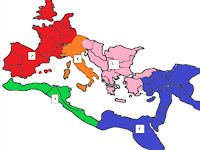Pausanias describes a giant mural by the famous artist Polygnotus. This is one of the scenes depicted on this (now lost) famous masterpiece, which depicts the Underworld:
Infra Uylyssem in soliis sedent Theseus & Pirithous: Theseus Pirithoi ensem, & suum ipsius, ambabus manibus stringit. Ad gladios respicit Pirithous: indignari videtur, quod ad facinus capessendum, quod animo agitabant, nulli sibi sint illi enses usui. Panyasis versibus testatus est suis, non fuisse illos tanquam captivos ad solia religatos, sed quasi agnatum adhaesisse pro vinculis corpori saxum. Celebrem hominum sermone eorum amicitiam utraque poesi nobilitavit Homerus. Ulysses enim apud Phaeacas sic est de ipsis locutus:
VIDI ETIAM, IUVIT
QUOS TUNC VIDISSE PRIORES
THESEA,
PIRITHOUMQUE, DEUM DE SEMINE CREATOS.
Et in Iliade quum
alia Nestor, Agamemnonem & Achillem ad reditum in gratiam adhortans, tum
illa memorat quae sunt his versibus perscripta:
NAMQUE VIROS
NUMQUAM VIDI, TALESVE VIDEBO
QUALEM PIRITHOUM
FORTEM, REGEMQUE DRYANTA,
CAENEA &
EXADIUM, & SUPERIS SIMILEM POLYPHEMUM,
THESEAQUE AEGIDEN
DIS IMMORTALIBUS AEQUUM.
κατωτέρω δὲ τοῦ Ὀδυσσέως
ἐπὶ θρόνων καθεζόμενοι Θησεὺς μὲν τὰ ξίφη τό τε Πειρίθου καὶ τὸ ἑαυτοῦ ταῖς
χερσὶν ἀμφοτέραις ἔχει, ὁ δὲ ἐς τὰ ξίφη βλέπων ἐστὶν ὁ Πειρίθους: εἰκάσαις ἂν ἄχθεσθαι
τοῖς ξίφεσιν αὐτὸν ὡς ἀχρείοις καὶ ὄφελός σφισιν οὐ γεγενημένοις ἐς τὰ
τολμήματα. Πανύασσις δὲ ἐποίησεν ὡς Θησεὺς καὶ Πειρίθους ἐπὶ τῶν θρόνων
παράσχοιντο σχῆμα οὐ κατὰ δεσμώτας, προσφύεσθαι δὲ ἀπὸ τοῦ χρωτὸς ἀντὶ δεσμῶν
σφισιν ἔφη τὴν πέτραν. [10] Θησέως δὲ καὶ Πειρίθου τὴν λεγομένην φιλίαν ἐν ἀμφοτέραις
ἐδήλωσεν Ὅμηρος ταῖς ποιήσεσι, καὶ Ὀδυσσεὺς μὲν πρὸς Φαίακας λέγων ἐστὶ “καί νύ
κ᾽ ἔτι προτέρους ἴδον ἀνέρας οὓς ἔθελόν περ,
“Θησέα Πειρίθοόν
τε, θεῶν ἐρικυδέα τέκνα:”
πεποίηται δὲ αὐτῷ
καὶ ἐν Ἰλιάδι ὁ Νέστωρ ἄλλα τε ἐπὶ Ἀγαμέμνονος καὶ Ἀχιλλέως νουθεσίᾳ καὶ ἔπη
τάδε εἰρηκώς:
“οὐ γάρ πω τοίους
ἴδον ἀνέρας οὐδὲ ἴδωμαι
οἷον Πειρίθοόν τε
Δρύαντά τε ποιμένα λαῶν
Καινέα τ᾽ Ἐξάδιόν
τε καὶ ἀντίθεον Πολύφημον
Θησέα τ᾽ Αἰγείδην
ἐπιείκελον ἀθανάτοισιν.”
--Pausanias Graeciae Descriptio X.xxix.9; Translated into Latin by Romulus Amasaeus (1696)
Below Odysseus, Theseus and Pirithous are sitting down on
chairs. Theseus holds his and Pirithous’ swords in his hands, and Pirithous is
glaring at them. Pirithous seems upset, because these swords were useless in accomplishing
his daring deed.* In his poetry, Panyassis stated that Theseus and Pirithous
were not bound to these chairs, but that the rock encased their flesh, serving
as a binding.
10. Homer mentions the famous friendship [φιλίαν] between Theseus and Pirithous in
both of this works. For [in the Odyssey], Odysseus says the following when he
is with the Phaeacians:
“Now I wished I could have seen the famous men of the
past, Theseus and Pirithous, famous children of the gods.” [Homer, Odyssey
11.631ff].
And in the Iliad, when Nestor offers advice to Agamemnon and
Achilles, he says,
“I have never seen the sort of people
As Pirithous,
Dryas, the leader of men,
Caeneus,
Exadium,
godlike Polyphemus,
and Aegeus’ son Theseus, equal to the gods.”
[Homer, Iliad,
1.262ff]
* According to mythology, Pirithous attempted to abduct
Persephone from the Underworld
PAUSANIAS
MAP:
Name: Pausanias
Date: 110 – 180 CE
Works:
Description of Greece
REGION 5
BIO:
Timeline:
Pausanias was a Greek writer who lived
during the era of the “Five Good Emperors.” His work, the Description of
Greece, is an important source for geographical, historical,
archaeological, and cultural information about ancient Greece.
ROMAN GREEK


No comments:
Post a Comment
Note: Only a member of this blog may post a comment.